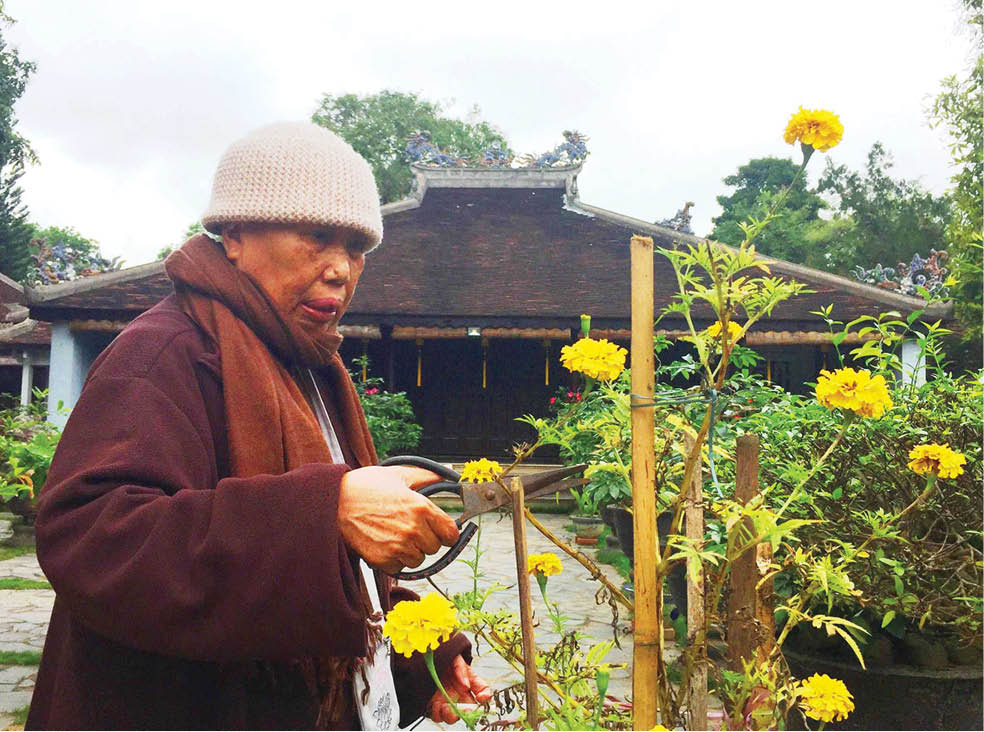
The triple gate at Dong Thuyen Pagoda. Photo: DANG TUYEN
The pagoda and the princess
As the saying goes: “Dong Thuyen drum, Thien Mu bell.” Dong Thuyen (or Dong Thien) is an ancient pagoda built by the venerable monk Te Vy, a disciple of Patriarch Lieu Quan (the 36th generation of Lam Te Zen Sect) in late 18th century, presently in Thuy Xuan Ward, Hue City. The special thing about the pagoda is it still keeps its simple yet exquisite architecture of the fine arts of the Nguyen Dynasty.
The pagoda is located on a turtle-shaped hill with a winding creek at the foot and surrounded by beautiful fields and lots of hills and mountains. The airy pagoda is nearly 3,000m2 wide with lots of trees.
At the beginning, Dong Thuyen was just a small temple created by Te Vy so that he could look after the nearby stupa of his master, Lieu Quan. It is said that Te Vy built the temple for himself and he probably did not accept any disciple. After his death, the temple fell into ruins and the land was abandoned. People in Duong Xuan used the land for cultivation from the time when Trinh soldiers invaded Thuan Hoa.
In the early-19th century, Princess Nguyen Phuc Ngoc Co, the thirteenth daughter of Emperor Gia Long and Nguyen Dinh Thi Vinh; after her husband and two children passed away, she decided to become a nun. Princess Ngoc Co used her own money with the support of Emperor Minh Mang to buy the land, rebuilt the pagoda and named it Dong Thien. She also set up an altar in the pagoda to worship Te Vy.
According to the Buddhist tradition, nuns are not allowed to start a pagoda. Ngoc Co had to ask a prestigious monk named Dao Trung Tam Hau from Thuyen Ton Pagoda to be the honorable ceremony host. Princess Ngoc Co also built an ancestral house behind the pagoda to worship her husband, the prince consort Nguyen Huynh Thanh, her children and her parents-in-law and asked people in Duong Xuan to take care of it.
In the 19th year of Minh Mang’s reign (1838), villagers restored the pagoda and set up a stele about the story. Dong Thuyen Pagoda and the ancestral house share the same campus. They are closely connected with each other.
In the 1930s of the 20th century, the pagoda fell into desolation because no one lived in there. After 1975, the venerable nun Dieu Khong agreed to take over the pagoda and assigned Dieu Dat to restore activities there.

Dieu Dat is tending the pagoda garden. Photo: HO HOANG THAO
Once-famous souvenirs
In the Minh Mang’s and Thieu Tri’s eras, the pagoda continued to be embellished. There remains a stele in the pagoda about this. The pagoda now still keeps its original architecture, the bronze khanh dating from the Te Vy period, the lacquered and gilded board of the Thieu Tri’s era, the stone stele of the Minh Mang’s era, the ancient statue and the ancient drum considered the biggest in Hue. (Khanh is a metal plaque making sounds when hit.)
The ancient drum at Dong Thuyen Pagoda is about 2 meters in diameter and 3 meters long with steel hooks inside to make it firm.
The pagoda also boasts a bronze khanh, engraved with the words "Donated by Nguyen Thi Chau and her son Truong Van Dang to the Three Jewels of Dong Thuyen Pagoda. Praying for bright days and for the wheel of the dharma to spin forever.” According to researchers, it was the 5th of December, 1967 when Te Vy was still alive, in the Lord Nguyen Phuc Thuan’s era.
In 1844, Princess Ngoc Co had the bell made with the names of the princess, her mother Nguyen Dinh Thi Vinh, Mrs. Phan Van Thi Hac and Mrs. Dang Cong Thi Luc and some others inscribed on it with the presence of the venerable monk Te Chanh Bon Giac.
The bell weighs 398kg, about 1 meter high, 1.3-1.4 meters high if the bo lao as the handle is included, (bo lao is a kind of dragon.) The bell body is engraved with Chinese characters and simple patterns.
Those once-famous drum, khanh and bell are now in ruins. According to Dieu Dat, the drum is still kept in the storehouse, but it has been ruined. The khanh and the bell decayed a long time ago. However, there remains a stone stele on campus.
It is said that the stele was originally located in front of the ancestral house. In 1976, when restoring the pagoda, thinking it belonged to the pagoda, people moved it to the front yard of the Great Hall and set it up on the left. In 1988, Dieu Khong had the part about fields and land erased and had the Vietnamese version inscribed on the back of the stele. The stele (140cm X 80cm) was made in the 19th year of the Minh Mang’s reign (1838) when the princess was still alive.
By HO HOANG THAO